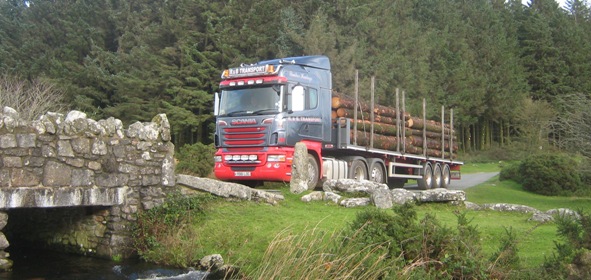The simple answer is as big as possible! This gives economies of scale for foresters and woodland managers, but is also good for wildlife. But then the accountant or bank manager gets involved, and it becomes a question of what can you afford?
From a wildlife point of view, the technical phrase is island biogeography; increasing a woodland (or indeed any nature reserve) by tenfold roughly doubles the number of species that will be able to live and survive there. Some species are rare, occupying quite specialist niches, and therefore are only found on big sites; in this country quite a few butterfly species are good examples, e.g. the Large Blue and Heath Fritillary. Other species, often at the top of the food chain just need large areas, and plenty to eat. Historically in this country lynx and brown bears would fall into this category. This is why there is much emphasis these days on landscape scale conservation, and encouraging ecological connectivity between sites. That connectivity can be shelter belts or mature hedges, or indeed minimising the distances between different blocks of woodland.
Putting wildlife to one side, the Forestry Commission used to deal with woods and grant aid planting areas of a minimum 0.6 acres, or 0.25 hectares, and wanted the wood to be at least 30 metres wide. If your interest is more along the lines of a sustainable source of firewood, then 5 acres may be a better size to aim for. In theory you could produce 15 tonnes a year from such an area, although that would be working it very hard. Five acres therefore leaves enough room for undisturbed habitat, leaving some dead wood for invertebrates etc. However, conifers are more difficult to manage in small areas; markets and machinery are all geared to large scale harvesting, with transport by the 20 tonne lorry load.
The current trend in the market is to split woods, and we have done that ourselves, but always seeking to ensure future parcels can be managed cost-effectively, with good access and tracks. A good track for a forest machine can also be a butterfly ride, and the ideal circular walk for an owner and dog. We also work with old “natural” boundaries, be they old stone and earth banks or watercourses, rather than an arbitrary line on a map becoming an arbitrary series of paint marks in a wood. We never divide a wood into a size we think will harm its long term management and conservation, even if it means selling at a lower price per acre.
Small woods and sub-dividing does have some advantages, including leading to a diverse range of management, and woodland structure. It also brings prices within the range of more people, although small woods do typically attract a significant premium. The increase in the number of woodland owners in the last twenty years has driven the market for woodland, and meant that woods of all shapes, sizes and descriptions have been a sound investment.
Kathryn and I started with just under three acres of old market garden, bought for £3,000 and planted in 1985. My younger brother bought an Austin Maestro at almost the same time for the same money; my mother thought I was a bit mad, but I think I know who had the better deal! Later we graduated to thirteen acres at Treragin (that set us back £31,500 at the time), and it still gives me far more pleasure than mowing the lawn at home. Going up in the world, Wildlife Woodlands is currently managing about 150 acres of woodland.
I was stimulated to write this article by a recent offering of 0.27 acres by another firm (not Woodlands for Sale!), which formed part of a much larger woodland and Site of Special Scientific Interest. Well I think that is too small, and is likely to damage the long term management of that wood. I would tend to suggest going smaller than five acres is a bad idea, unless the wood is an isolated and defined area. I would also suggest conifer woods should remain in larger blocks. For those that cannot afford to buy such an area, then it may be worth considering shared ownership, or helping at a local community wood. More and more of these are springing up, and I will have a look at those in my next blog.
Stephen





